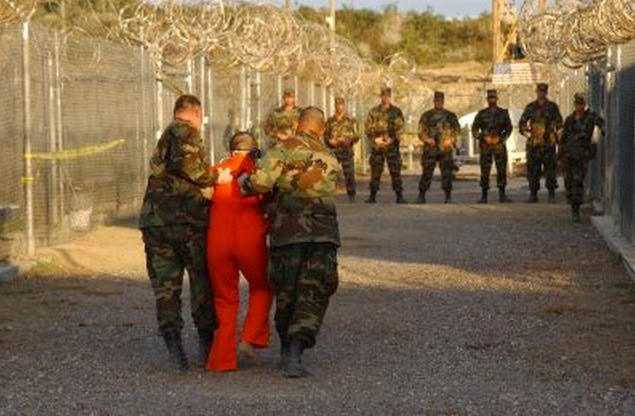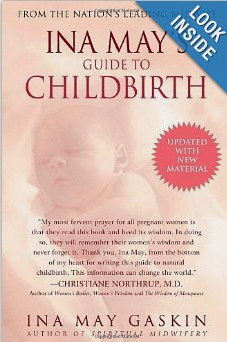Images of life on The Farm appropriated with great gratitude from an anonymous blog:
What Was It Like To Grow Up On America's Largest Commune? In The Late 60'S, 320 San Francisco Hippies Took a Caravan of 60 Buses Across the Country and Founded "The Farm" in 1971 on 1,750 Acres in the Backwoods of Tennessee. It Reached a Peak of 1500 People, All Who Took a Vow of Poverty to Live Communally, Self Sufficient Off the Grid. During the 70'S and Early 80'S, Hundreds of Children Grew Up Knowing Only This Reality. Living in Tents and School Buses, Knowing Nothing of TV, Packaged Food, Meat, Make-up, Pavement or Electricity, Secluded in Another World of Farming, Horse Wagons, Outhouses, Home Birth, Rock and Roll, Pot Smoking, Meditating and Oming. I'm Going to Do My Best to Share What It Was Like From the Viewpoint of My Child Self Who Knew No Different Starting From the Beginning…
The Hippie New Age Christ And The Second Coming, by Thomas Ivan Dahlheimer,
Wahkon writes

The hippie counterculture revolution is making a
comeback and its leaders will soon usher in a new age and new world order. The spirituality of the New-Age hippies of the 1960s has found its way into many Christian Churches. This is causing a growing number of Christians to radically transform their faith, so that it embraces the hippie New-Age Hindu/Buddhist spiritual philosophy. Many are doing this to prepare themselves and the world for the Second Coming of Jesus Christ and the establishment of the fullness of the Kingdom of God on earth.
The hippies' New-Age spirituality of the 1960s is now being called the
New Spirituality. A big part of what is causing the
New Spirituality to increase in popularity is the fact that modern-day scientific discovery has revealed that, both, the central foundational dogma of Christianity/Catholicism is a false dogma and Hindu beliefs and scientific truth are compatible.
One of the leaders of the New Spirituality movement is the internationally acclaimed spiritual theologian Rev. Matthew Fox, a former Roman Catholic priest. He will be one of the speakers at "The New Spirituality" session during an up coming
Science and Nonduality Conference.
Some of the people who have embraced the New Spirituality say they are of a "
new form of Roman Catholicism" and that they now have a "
new eschatology." They are beyond the dogmatic boundaries of the Roman Catholic Church. However, they believe that eventually the Holy See will
"deconstruct" the church and then establish a new church that will have the New Spirituality. I also believe that a new church will be established. And I believe that it will be named the Wahkon Catholic Church.
I became a hippie in the late 1960s. After my conversion to the hippie revolution I left my home town of Anoka, Minnesota and travailed to the San Francisco Bay Area of California where I met and became friends with Richard H. Carter, one of the leaders of hippie counterculture revolution. After spending a few years in the Bay Area I moved back to Anoka. It was not long after I returned to Anoka that I then moved to Wahkon, Minnesota.
After moving to Wahkon I came to believe that I was in the prophetic forefront of the hippie counterculture revolution and that I and my relatives of the Mr. & Mrs. I. C. Rainbow family, my extended maternal kinship family, would eventually come together in kinship tribalism in the town of Wahkon, Minnesota, and that the Rainbow family would then, with help from close associates, usher in a new age and new world order.
During the 1983 Mr. & Mrs. I. C. Rainbow family reunion my uncle Don Rainbow addressed the seventeen families gathered at that Rainbow family reunion and said: "A Rainbow is a sign of God's salvation plan, and I believe that we may be used to glorify God more than any other family in the world."
Don Rainbow made this very grandiose statement after I spoke to him about (1.) my 1983 Tekakwitha Conference meeting with the (mentioned above) world renowned Rev. Matthew Fox, a visionary and author, who was the keynote speaker at the 1983 annual Tekakwitha Conference, a Roman Catholic Native conference representing over one hundred tribes, and (2.) my mission to bring the I.C. Rainbow family together in kinship tribalism to promote the tribal way and my expression of the hippie countercultural revolution.
This article presents an update on my Rainbow family mission. Here's one recent key development: The Mille Lacs Messenger, a Minnesota county newspaper, recently published a letter of mine titled
Revolution. The letter is about my Rainbow family mission.
Some more key developments:
On July 25, 2013 - the creator and webmaster of an interactive website with over 225,000 registered members Skip Stone posted my Mille Lacs Messenger letter
Revolution on his website. We correspond and he has a special section on his popular Hippyland or Hippy.com
website, a section/site named
Coolove.org, where he, on the
main page, has, for years, exclusively posted articles of mine. Some of my Hippyland articles are about my Rainbow family mission. My letter "Revolution" is posted on Coolove.org with a new title:
A Revival Of The 1960s Countercultural Revolution.
On August 6, 2013 - Indian Country Today Media Network, the world's largest Indian news source, posted my letter "Revolution" as a comment to Steven Newcomb's article
A Path for Indian Nations to Liberate Themselves From U.S. Colonialism? My comment is one of two selective ICTMN comments posted on this article by Newcomb. In the introduction to the ICTMN post of my letter "Revolution" I state that the letter is about "a plan to liberate Indigenous peoples from colonialism."
Three recently published Mille Lacs Messenger (MLM) letters of mine,
American Colonialism,
On Neo Conservatives and
Agenda 21, were lead-in letters to my letter "Revolution." My lead-in letter titled "On Neo Conservatives," was posted on two special ICTMN articles prior to the posting of my letter "Revolution." One of the articles was written by Winona LaDuke. Its title is
When Drones Guard the Pipeline: Militarizing Fossil Fuels in the East. The other article was written by Steven Newcomb. Its title is
One Nation, Under Domination, With Liberty and Justice for None. Both LaDuke and Newcomb are world renowned Indigenous/Indian activists. Only a few selective comments were posted on their articles.
Also, prior to the ICTMN posting of my letter "Revolution," my MLM letter
American Colonialism was posted on Newcomb's ICTMN article
U.S. Colonialism: The Cornerstone of U.S. Indian Policy. Only three comments were posted on the article.
Indigenous Peoples Literature, a very popular news source, or site, that has received over 10,000,000 visitors, posted the same three MLM letters that ICTMN posted:
American Colonialism,
On Neo Conservatives and
Revolution.
Steven Newcomb is an ICTMN columnist and world renowned Indigenous activist who is on the forefront of the global Indigenous decolonization movement and he works closely with the United Nations. We correspond and he has given his assistance with activists initiatives of mine. ICTMN has published or posted
several comments and letters of mine. Some of the comments are posted on articles by Newcomb. One ICTMN
letter is partially about the assistance I received from Newcomb when I was working on a draft Minnesota Apology Resolution - a draft resolution that was eventually completed, edited by Rep. Dean Urdahl, and then introduced as a
house concurrent resolution to the Minnesota legislature.
A submitted facebook post of mine, which included a link to Skip Stone's Coolove.org post of my MLM letter "Revolution", was approved and is now displayed on Daniel Quinn's facebook
site. Mr. Quinn is a world renowned visionary. He is on a mission to retribalize the world. His name, plus information about his visionary mission, is presented in my MLM letter "Revolution", a letter that is (on my site) titled
My Mission To Retribalize The World.
____________________________________________________________________________
Richard Carter and
Steven Gaskin
In the late 1960s Richard Carter often attended Stephen Gaskin's Monday Night Class at the Family Dog Ballroom in San Francisco, California. Around 1500 hippies participated in the class. At that time Carter met and spoke with Gaskin a few times. Several years ago a letter of mine to Gaskin's hippie community, a community located in a rural area of Tennessee and called "The Farm", was published in the community's newsletter. The letter states that when Gaskin's hippie community was forming in the San Francisco Bay Area...Richard Carter, his wife (Lois) and I were beginning to get a commune together to leave the Bay Area and move to a rural area. And that, at that time, we traveled to the town of Wahkon, located in a rural area of Minnesota, where we, for a while, pursued the goals of our countercultural mission. The letter also states that I believed that, in due time, Richard, Lois and I would be together again in Wahkon pursuing the same countercultural goals, and eventually successful at accomplishing our countercultural goals.
Monday Night Class at the Family Dog Ballroom
Richard Carter recently began corresponding with me and he has given me some assistance with my mission. He has indicated that he now supports my indigenous peoples' rights activist work and related hippie countercultural, Rainbow family mission. He is an environmentalist who was the Governor of Arizona's Environmental Delegate to both the U.S./Mexico Border Governor's and Mayor's Conferences for five consecutive years and Co-Chairman of the Arizona Environmental Technology Industry Cluster.
Richard Carter is the Founding President of the 200+ member Southern Arizona Environmental Management Society. It is based in Tucson, Arizona and named Carter Affiliates, Inc. Resources for the Environment (CARE)
_______________________________________________________________________________
Albert Bates
Albert Bates is a hippie icon. As stated in my MLM letter Revolution "Bates is the spokes person for Stephen Gaskin's world-renowned hippie community." Bates is the author of the book Climate in Crisis, introduced by Al Gore. As an attorney Bates argued environmental and civil rights cases before the U.S. Supreme Court and drafted a number of legislative Acts during a 26-year legal career.
On the home page of Skip Stone's Hippyland
website there is a list of "Old Articles." My article
Creating a new culture based on tribal values is located on the top of the list. When I wrote the article I was of a somewhat hippie New Age expression of Catholicism and moving toward a full convertion to the hippie New Age spiritual philosophy within the "new form of Roman Catholicism." I made that convertion and I am no longer a member of the Roman Catholic Church. My Hippyland/Coolove.org article presents some information about Bates and his correspondence with me.
An old article of mine titled "A 1960s hippie activist" is displayed on Skip Stone's Hippyland "Activist Spotlight" forum. The article, plus my introduction to it, is displayed on my
website. My introduction to the article includes information about Albert Bates and his correspondence with me.
Bates is also an influential figure in the intentional community and ecovillage movements. He served on the steering committee of Plenty International for 18 years, focussing on relief and development work with indigenous peoples, human rights and the environment.
_______________________________________________________________________________
Two more articles about my mission:
Another article about my mission is titled
Constance Cumbey, Matthew Fox and the "New Age Christ." It was written in response to Constancy Cumbey's blog post about me. It is titled
The Fifth Seal? The Persecution of the Church? Cumbey's best-selling book The Hidden Dangers of the Rainbow is credited as "being successful at waking the Christian church up to the New Age movement." Cumbey identified the New Age movement as the movement that will produce the biblical "end-time Antichrist" and then establish a New World Order. In her blog post about me and my "close affiliation" with the world renowned Rev. Matthew Fox, Cumbey indicates that she believes that I could be the "end-time Antichrist" or "New Age Christ."
The rainbow is a sign of the New Age movement. I am of the hippie expression of the New Age movement and working to evangelize my Rainbow family to it. I believe that eventually I and my Rainbow family relatives, along with some close assocoates/friends of the Rainbow family, will usher in a New Age...by establish the fullness of Kingdom of God on earth. (Rev. 4:2, "..., and there was a rainbow round about the throne,...")
A webpage of mine titled
Science and Religion presents several MLM letters that explain why I left traditional Christianity, but remained a follower of Jesus Christ.
Today, Jesus Christ is my divine New-Age Hindu/Buddhist guru. He is my hippie guru and New Age leader who has the most glorious mission.
I believe in Sri Yukteswar's teaching: "Jesus meant, never that he was the sole Son of God, but that no man can attain the unqualified Absolute, the transcendent Father beyond creation, until he has first manifested the 'Son' or activating Christ Consciousness within creation. Jesus, who had achieved entire onenness with that Christ consciousness, identified himself with it inasmuch as his own ego had long since been dissolved."
I also believe that some of the scriptures were inspired by God and that the other Bible scriptures were written by people who were influenced by a supernatural being who was evil and very deceptive. And I believe that because of what modern day science has discovered about the origin and evolution of life on earth-people who accept the truth [revealed by science] now know that the central foundational dogma of Christianity, a dogma based on the Bible's thesis, is a false dogma and
deceptive lie.
When the U.S. Catholic Bishops wrote about the scriptures that form the thesis of the Bible, they wrote: "The whole Bible is spanned by the narrative of the first creation (Gn 1:3) and the vision of a restored creation at the end of history" (RV. 21:1-4). The Catechism of the Roman Catholic Church says: "Jesus came to restore creation to the purity of its origins" (CCC, n. 2336). A Bible scripture states that "the creation itself", will be "delivered from bondage to corruption." (Romans 8:21)
Scientific discovery has revealed that the creation was not originally pure, or without death and corruption, prior to the exsistence of the first human beings on earth. This proves that the creation could not have fallen into "the bondage to corruption", causing the death principle to enter the world, at the time when the first humans ("Adam and Eve") committed "original sin." Therefore the creation can not be "restored to the purity of its origins."
Let us examine the teachings of the Roman Catholic Church that describe the supposed original purity of the creation.
St. Symeon explicitly stated that not only Paradise was incorrupt before the Fall: everything, the whole creation, was without death and corruption.
St. John of Damascus wrote: "The creation of all things is due to God, but corruption came in afterwards due to our wickedness. For God did not make death, neither does He take delight in the destruction of living things. But death is the work rather of man, that is, its origin is in Adam's transgression."
St. Ignatius Brianchaninov wrote: "Plants were not subjected either to decay or to diseases; both decay and diseases and the weeds themselves, appeared after the alteration of the earth following the fall of man."
St. Basil the Great wrote: "It is customary for vultures to feed on corpses, but since there were not yet corpses, nor yet their stench, so there was not yet such food for vultures. But all followed the diet of swans and all grazed the meadows, the beasts were not carnivores, such was the first creation, and such will be the restoration after this."
Violent complex carnivorous animals came into existence on earth around 550 million years before the first humans came into existence. Contrary to what Bible scriptures and the Christian religion teach, for hundreds of millions of years before "Adam and Eve" there were a lot of corpses for carnivores animals to eat. The creation was not originally pure. From the origin of life on earth there was a measure of violents and corruption that existed, as well as death. Since the origin of life on earth death and corruption have ruled the world.
I believe that, today, everyone who is not caught up in a religious delusion knows that the above statements by saints are not true and that the creation was not originally "pure" and then fell into "the bondage to corruption" when the first humans ("Adam and Eve") sinned. Therefore, I believe that people who know the truth believe that the scriptures that form the thesis of the Bible are false and very deceptive.
I also believe that the scriptures that warn Christians about the "end-time Antichrist" are deceptive. I believe that the "end-time Antichrist" is actually a good guy who will establish the fullness of the Kingdom of God on earth.
In Cumbey's blog post about me she wrote: "Lee Penn and I have both wondered out loud if Mr. Dahlheimer had read our respective books and took everything we warned against as something positive and wonderful for the world. Cumbey later wrote, Lee Penn and I were correct: Dahlheimer has inverted everything! Lee Penn will be on air with me tomorrow night. We will be talking about Thomas Dahlheimer."
Bishop William Swing is the President and Founder of the United Religions Initiative (URI), an international organization affiliated with the United Nations and modeled after the UN. Not long after Bishop Swing accepted Matthew Fox as an Episcopal priest, Lee Penn wrote: "The interfaith movement, including the URI, is being promoted by globalist and New Age reformers who favor erosion of national sovereignty, marginalization of traditional religions, establishment of 'global governance', and creation of a new, Earth-based 'global spirituality' -- in effect, a one-world religion. Therefore, the URI and the interfaith movement are poised to become the spiritual foundation of the New World Order." Cumbey and Penn "warn agianst" this. I believe it is "something positive and wonderful for the world."
Archbishop Javier Lozano Barragan, a world-renowned theologian and former president of a Pontifical Council, called the UN led global ethic movement an "eco-religion". He said it manifests itself "as a new spirituality that supplants all religions, because the latter have been unable to preserve the ecosystem."
I believe that hippie New Age reformers will eventually gain recognition as being in the prophetic forefront of the "global governance" and "Earth-based global spirituality" movement and that these hippie New Age reformers, especiallly including myself and other members of my Rainbow family, will then usher in a New Age and New World Order.
Another article about my mission is titled
The Latter Rain/New Age Movement. It's also located on the Creation Spirituality Communities
website. In this article I first show how two different movements are similar, the New Age movement and the Christian "Manifest Sons of God" movement. I then explain how I incorporated the Manifest Sons of God "dominion theology" into my hippie expression of the New Age movement. A part of the article reads:
"The New Agers believed they were gods. The Manifest Sons of God likewise taught that if one accepted their 'new revelation' that they themselves would actually become Christ at the time of the unveiling or 'manifestation of the Sons of God.'" (Romans 8:19)
"This teaching is part of what is known as 'dominion theology' which teaches that an elite army of 'overcomers' will either destroy or subdue all the enemies of Christ until they eventually gain power and authority throughout the world. The government of the nations will be upon their shoulders and when all the secular authorities, governments, princes and kings have finally submitted to them, Christ will return and they will present the kingdom to him."
"What is about to come upon the earth is not just a revival, or another awakening; it is a veritable revolution."
_________________________________________________________________________________

Steve Gaskin - The Farm, Yogi Bhajan - 3HO, Swami Satchidananda - Integral Yoga
Speaking to the audience at Holy Man Jam, Boulder, CO June 1970 © Lisa Law
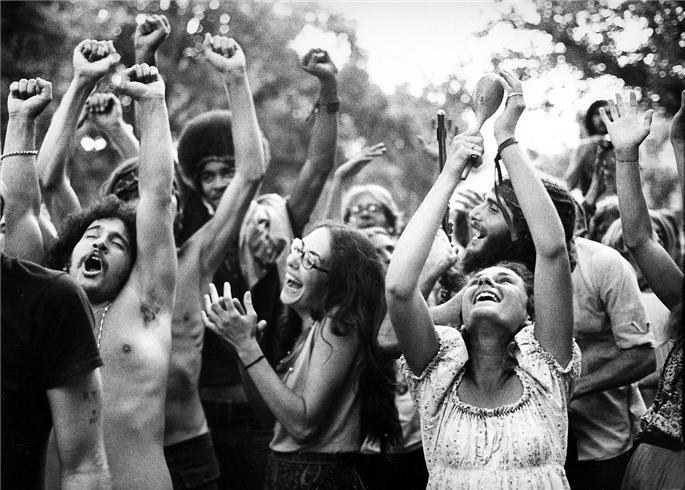
Youths exalting at Holy Man Jam, Boulder, CO, June 1970
Photo by Robert Altman
 * * |
Stephen Gaskin (1935 - ), ca. 1969. Gaskin's commune, The Farm, still exists.
-32-
In 1966, Stephen Gaskin began giving his "Monday night talks" in San Francisco, synthesizing a variety of esoteric ideas with a "back-to-the-land" ethic, resulting in the eventual formation of The Farm (TN), an alternative spiritual community. In 1967, at the First Unitarian Church of San Francisco, Abraham Maslow, borrowing heavily from eastern ideas, initiated the beginning of Transpersonal Psychology which has continued to draw on and to inform esoteric thought in America and to do scientific testing on advanced practitioners of Eastern esotericism (133). In 1968, Joan Gibson formed the Church of Inner Wisdom, combining the teaching of New Thought with emphasis on psychic abilities, "macro-ontology," and the teachings of various prophets and leaders of world traditions(134). During the 1970s, Counter-cultural movements in American and Europe led many to embrace western esoteric and eastern ideas or practices and to positively engage with other cultures. A single memorable example is the 1971 publication by Ram Dass (Richard Alpert) of his Be Here Now, Remember, an extremely popular text outlining his trip to India and giving a poetic rendition of new insights into an east-west synthesis and esotericism.

Council of Elders
This is the message we heard from the Council of Elders at the EarthDance 2006. The Council was comprised of ambassadors from around the world, representing a wide range of ethnic, religious and social groups. From a Mongolian shaman to a living Chinese Buddha to Wavy Gravy they spoke with one voice, declaring that now is the time for all good people to unite as one, to share their knowledge, prophecies and experience for the good of all.
Earthdance is symbolic of a new renaissance of awareness that is sweeping around the globe. Everywhere people are waking up to the idea that we must unite in order to survive what is coming. Indeed, Earthdance is a Global Festival for Peace, with people in 250 locations in 50 countries from Argentina to Zambia participating in the event.
The highlights of the festival were the Council of Elders and the Prayer for Peace where the Elders gathered onstage to lead the prayer which was simultaneously occurring in those 250 locations and elsewhere around the world.

St. Stephen entralls as always
Off to the right were the people like St. Stephen Gaskin and his wife Ina May Gaskin, as well as Guatemalan and Colombian healers. Source
_________________________________________________________________________________
If spiritually-based collectivism is a path to actualization, then the award for "The Most Well Worn" would go, hands down, to The Farm,
If an evolved ethos and practice of intentional community and cooperation are integral to saving the world from humanity, then The Farm's history ought to be required study for those who would pursue it.
The Farm is the oldest and biggest intentional community. It's lasted longer than any others (from the sixties, at least). It once had as many as 1,500 members, a dozen locations and numerous service activities across the nation and abroad. It's aspired to foster spiritual growth, world peace and ecological harmony for over four decades.
The spiritual precepts of The Farm are not based upon the scriptures, teachings or dogma of organized western religions. The Farm's spirituality is a product of 1) the societal conditions of the Sixties within which they were formed and 2) the passionate efforts, predominantly of "the young generation," to explore and construct more promising alternatives. The very definition of radical: extreme, non-traditional; favoring drastic change. Even on the spiritual level.
The forces defining the times were toxic: the tragic escalation of the Vietnam War; impending atomic apocalypse; the reprehensible complicity and obedience of media and the monolithic mainstream population to militarism; fascistic demands for rote, unexamined conformity to superficial, repressive religious dogma and social and sexual mores; racism and sexism; the mechanistic, soul-sucking, morally bankrupt processes of corrupt capitalism, fraudulent government and the laws of the establishment upon students and workers; Madison Avenue's devious commercial propaganda, epitomized in subliminal advertising; the gathering environmental storm being fueled by scientific hubris and industrial-strength greed, as revealed in Rachel Carson's The Silent Spring, Murray Bookchin's Our Synthetic Environment and other exposés.
The inquisitive minds among which future Farm members' thoughts and beliefs were developing found instruction in political philosophy, the history of social justice and revolution, and Eastern religion. They practiced activism and civil disobedience. The contemporary creative community affirmed their judgments and rebellions. Underground, some experimented with anarchism and militant opposition. And most received copious amounts of marijuana and head-spinning psychedelic experiences, which resonated, vibrated actually, with many.
And they were nourished by meditation and the calming, hopeful pursuit of enlightenment, inner peace, global equilibrium, and cosmic union.
The Farm today is far different from that which was founded. There are a few people who have been called or who have called themselves co-founders of The Farm. Certainly the efforts and achievements of The Farm have required and involved massive collective action. And the role of "leadership" has changed substantially. But the farm had a founding leader who was the spiritual guide, and that was Stephen Gaskin.
Because of this, some considered The Farm a cult. The Farm addresses this claim as follows:
Although we had our own jargon and other social eccentricities, in my opinion we did not cross the line to true cult status. Anyone was free to go at any time. We valued and encouraged relationships with your parents and family. All of us had our own psychedelic experiences that formed the foundation for our belief that we are all one, rather than relying on Stephen's experiences or believing a book to be the word of God. - The Farm FAQs
All this is true. As we know about such circumstances, however, the "freedom" to come and go would mean letting go of the pursuit of one's spiritual mission within the context of The Farm, under the guidance of a strong leader, among kindred spirits, relationships with whom had been forged in the fires of rebellion and hardship, ties that would not be so easily severed, even though one was "free" to do so.
One need only glance at a handful of photos of those early days to know that Stephen was the cause of The Farm, which originated as a San Francisco "happening."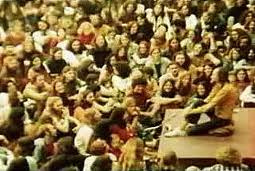
Tellingly, there appears to be as much information in the world on Stephen as there is on The Farm, though both are well covered. Accounts on both subjects vary. I can't claim to have completely teased out fact from fiction, anecdote from myth, or an inside scoop from sour grapes, grudges or gossip. But there's a fascinating story and some clear, hard lessons to be had here nevertheless.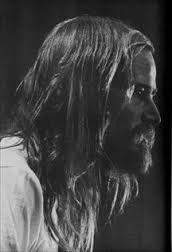
Stephen Gaskin (born February 16, 1935) is a counterculture hippie icon best known for his presence in the Haight-Ashbury district of San Francisco in the 1960s and for co-founding "The Farm", a famous spiritual intentional community in Summertown, Tennessee. He was a Green Party presidential primary candidate in 2000 on a platform which included campaign finance reform, universal health care, and decriminalization of marijuana. He is the author of over a dozen books, a father, a grandfather, a teacher, a musician (drummer), a semantic rapper, a public speaker, a political activist, a philanthropic organizer, and a self-proclaimed professional hippie.
[snip]
He went to prison in 1974 for marijuana possession, as members of the community had, against his recommendation, planted several marijuana plants on the property.[2] He served one year of a three-year sentence.[2] While in prison, a class action suit on his behalf returned voting rights to more than a quarter of a million convicts.
[snip]
Beginning in early '67, Stephen -- then an assistant professor of creative writing, semantics and English literature at San Francisco State -- cultivated a following by holding free Monday night "classes" in a series of increasingly larger venues.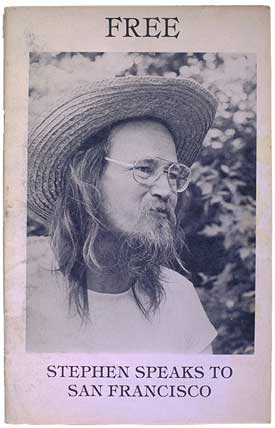

"The San Francisco Rock and Roll scene was invented by the Family Dog and the Charlatans. All we wanted to do was throw a big dance to raise money to buy land in Arizona to run a mail order pet cemetery." - Travus T Hipp (quote source)
Stephen and his audience sought a paradigm to unify the impulses, understandings and possibilities that the sixties (on acid) had awakened.
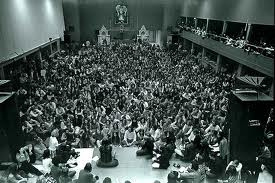
For many, the "trip" revealed an immediate, compelling intimation of oneness. Oneness was considered, prima facie, of supreme spiritual import. It made the need for peace and love both obvious and vital. And this oneness extended to the natural world. The trip was seen as a door to spiritual dimensions and new understandings of reality. One such epiphany recognized oneness on the material "plane" as the connection shared by all matter and energy through constant flux and exchanges within the atomic and quantum web.
Pretty sure this is where "far out" and "heavy" came from. :)
In this sense, conflict and violence with "others" is a war with "I," "I" being everything at once: people and nature. Volence and war among people or between man and nature became not merely not good but not good for anything. Ever. A complete dead end.
When people came to a class for the first time, they were usually somewhere on this line of thought. Some were nearer the beginning:
"Stephen's spellbinding tales of telepathy, amazing trips, realizations and apparent quantum leap in spiritual development -- encouraged me to trip," Stiriss writes. "Now, I believed I was tripping not just for myself, but for all Mankind. I was tripping to get enlightened, to save the world from ignorance, poverty and war." - Melvin Stiriss
Others came to him already much farther along.
"We were the kind of people who came out of the drug experience of the Sixties, who acknowledged vibrations and other realms of existence besides the material plane. We'd seen the Vietnam conflict escalate and many of us had been tear-gassed in the streets. We'd had some kind of spiritual realization that we were all
One and that peace and love were the obvious untried answers to the problems facing our society; many of us had given up our material possessions before we even met Stephen. That's the kind of people who started the Farm experiment." -Matthew McClure
The class did more than simply turn these concepts over in its mind.
Stephen would say, "Lets talk about how we're gonna be." Not "how we're gonna stop the war" or "how we're gonna make it fair," but "how we're gonna be." - America's Communal Religions
Having arrived at an understanding of how oneness, love, peace and the environment were related, the class also examined what it would mean to "be" that understanding in the world. Steven had the intellectual background, the spiritual awareness, and the charisma to lead that discussion. And that's why others followed.

As we shall see, the community of the class was not only contemplating "how to be", but preparing for putting those Words In Action. ;^)
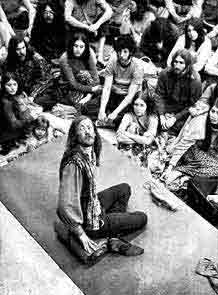
Note: Stephen's wikipedia entry does not mention his equally illustrious and influential wife, Ina May Gaskin. I've done the same but will describe her and work on The Farm at a later point.
_____________________________________________________________________________
.jpg)










.jpg)







